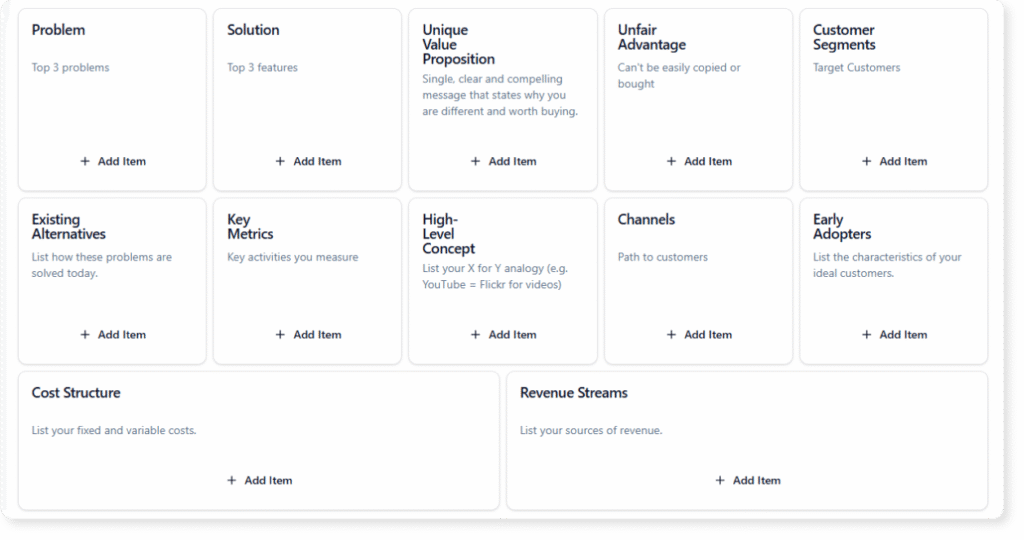Now Reading: 5 Common Mistakes to Avoid with the Lean Canvas
-
01
5 Common Mistakes to Avoid with the Lean Canvas
5 Common Mistakes to Avoid with the Lean Canvas

The Lean Canvas is one of the most effective tools for startups and innovators to define their business model quickly. Created by Ash Maurya as an adaptation of the Business Model Canvas, it focuses on identifying key risks, validating assumptions, and achieving product–market fit.
However, despite its simplicity, many teams misuse the Lean Canvas or fail to get real value from it. In this article, we will explore the five most common mistakes people make when using the Lean Canvas — and how digital tools like Canvas can help you avoid them for better, faster results.
1. Treating the Lean Canvas as a One-Time Exercise
One of the biggest misconceptions is thinking the Lean Canvas is something you fill out once and move on. The truth is, the canvas is meant to evolve as your understanding of the problem, customer, and solution deepens.
A static canvas leads to outdated assumptions and missed opportunities. The Lean approach emphasizes iteration — testing hypotheses, learning from data, and refining your model continuously.
How Canvas Helps:
Canvas allows you to update your Lean Canvas dynamically. You can duplicate earlier versions, record changes, and even request the AI Co-pilot to analyze how your model has evolved over time. This creates a clear trail of learning and improvement instead of a single frozen snapshot.
2. Starting with the Solution Instead of the Problem
Another frequent mistake is jumping straight into the solution box. Teams often fall in love with their idea before deeply understanding the problem it solves. The Lean Canvas is designed to start with the Problem block for a reason — it ensures your product addresses real pain points.
Without clear problem definition, the rest of the canvas becomes guesswork.
How to Avoid It:
-
Interview potential customers early.
-
Write down three core problems you are solving.
-
Validate each one before designing your solution.
How Canvas Helps:
In Canvas, you can ask the AI to suggest or refine problem statements based on your value proposition, ensuring each assumption is grounded in logic and evidence before you move forward.
3. Ignoring the Customer Segment Fit
Many creators focus heavily on the product but overlook who it is for. Defining customer segments clearly is crucial because different segments may have distinct needs, channels, and pricing expectations.
A mismatch between your problem and customer definition can make even the best product fail in the market.
Pro Tip:
-
Identify your early adopters — not just your general target audience.
-
Clarify which segments experience the problem most intensely.
How Canvas Helps:
Canvas can analyze your Problem and Solution sections together to identify missing connections. The AI will highlight inconsistencies, such as when your solution does not directly align with the customer segment you defined, helping you refine your model for a better fit.
4. Overloading the Canvas with Detail
The Lean Canvas is designed to be concise and visual. Overwriting each box with paragraphs of text makes it hard to read, compare, or communicate. The goal is to capture core insights, not to document everything.
When teams treat the Lean Canvas like a business plan, it loses its power as a quick, high-level strategic tool.
Better Approach:
Keep entries short and meaningful — ideally one to three bullet points per block. Use additional documentation or reports for detailed explanations.
How Canvas Helps:
Canvas provides structured input fields for titles, descriptions, and tags, allowing you to keep the canvas readable while linking to more detailed notes or external resources when necessary.
5. Skipping Validation and Metrics
The Lean Canvas ends with two critical boxes: Unfair Advantage and Key Metrics. Many users either skip them or fill them with vague ideas.
These sections force you to think about what truly differentiates your business and how you will measure success. Without them, you risk running your startup based on intuition instead of evidence.
How to Strengthen This Area:
-
Define measurable indicators for growth, engagement, or retention.
-
Identify assets competitors cannot easily copy — relationships, technology, or exclusive data.
How Canvas Helps:
With the built-in AI Analysis, Canvas can evaluate your metrics and provide suggestions on how to quantify progress or sharpen your competitive edge. It ensures your canvas is not just complete but strategically coherent.
Bonus Tip: Failing to Connect Canvases
Sometimes, teams isolate the Lean Canvas from other frameworks. In reality, it connects naturally to models like the Business Model Canvas, SWOT Analysis, or Customer Journey Canvas.
When you treat it as part of a larger strategic system, you gain richer insights and more actionable results.
Canvas Advantage:
Canvas supports multiple frameworks in one workspace. You can transition from a Lean Canvas to a SWOT or Product Canvas instantly, carrying your data forward while exploring your idea from new perspectives.
Conclusion
The Lean Canvas is a powerful, fast-moving framework — but only when used correctly. Avoiding these common mistakes ensures you focus on learning, validation, and clarity instead of getting stuck in assumptions.
With a digital platform like Canvas, you can go beyond sticky notes and manual updates. The AI-powered tools, structured layouts, and analysis features turn your Lean Canvas into a living document that grows with your business.
Whether you are refining an MVP or planning your next iteration, mastering these principles will help you make every version of your canvas sharper and more strategic.
